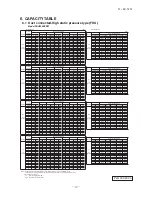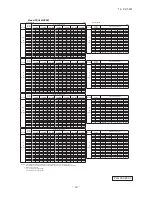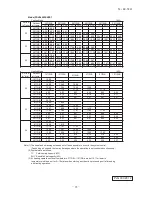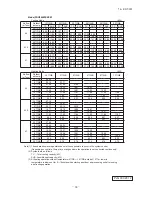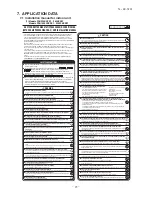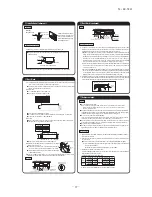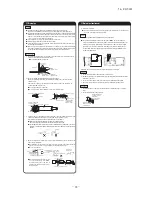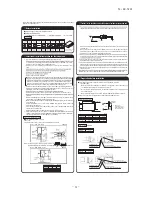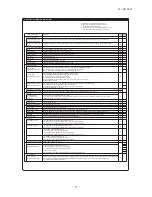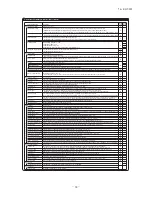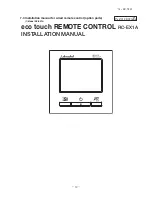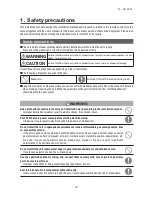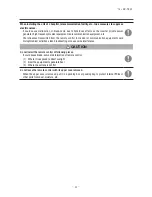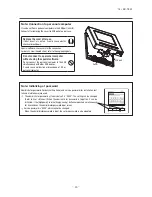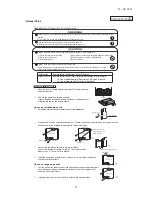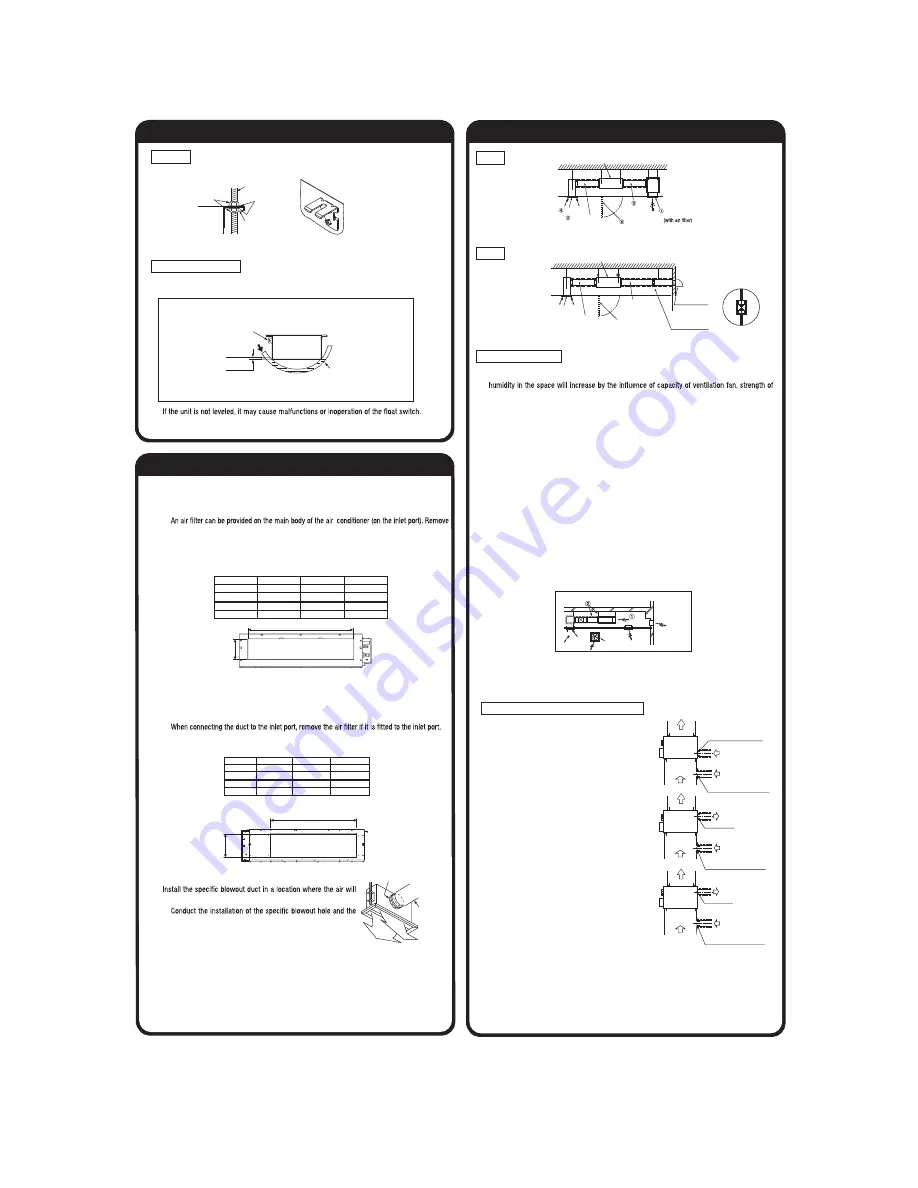
-
-
'14 • KX-T-222
⑧
Drain pipe
●
Install the drain pipe according to the installation manual in order to drain properly.
●
Do not put the drain pipe directly into the ditch where toxic gas such as sulfur,the other harmful
In addition, it may cause corrosion of heat exchanger and bad smell.
●
Connect the pipe securely to avoid water leakage from the joint.
●
Insulate the pipe properly to avoid condensation drop.
●
of the drain pipe after installation.
●
Make sure to make descending slope of greater than 1/100 and do not make up-down bend
and/or trap in the midway. In addition, do not put air vent on the drain pipe. Check if water is
inspection and maintenance.
1. Make sure to insert the drain hose (the end mode of soft PVC) to the end of the step part
of drain socket.
Attach the hose clamp to the drain hose around 10mm from the end, and fasten the
screw within 5mm left to the nut.
●
Do not apply adhesives on this end.
●
Do not use acetone-based adhesives to connect to the drain socket.
2. Prepare a joint for connecting VP-25 pipe, adhere and connect the joint to the drain hose (the
end made of rigid PVC), and adhere and connect VP-25 pipe (prepare on site).
※
As for drain pipe, apply VP-25 made of rigid PVC which is on the market.
●
Make sure that the adhesive will not get into the supplied drain hose.
●
leakage.
●
As for drain pipe, apply VP25 (OD32).
If apply PVC25 (OD25), connect the expanded connector to the drain hose, with adhesive.
(Multi unit only)
3. Make sure to make descending slope of greater than 1/100 and do not make up-down bend
and/or trap in the midway.
●
pipe as close place to the unit as possible when connecting the drain pipe.
●
Do not set up air vent.
●
When sharing a drain pipe for more
than one unit, lay the main pipe 100mm
below the drain outlet of the unit. In
addition, select VP-30 or bigger size for
main drain pipe.
Drain socket
Pipe cover (big) (For insulation)
(Accessory)
VP25 joint (Prepare on site)
VP25
(Prepare on site)
Pipe cover (small)
(For insulation) (Accessory)
Unit
Clamp (Accessory)
Pipe cover (small)
(For insulation)
(Prepare on site)
Drain socket
Metal plate
10mm
Hose clamp
Fasten the screw within
5 mm left to the nut.
Drain hose
Drain socket
Drain hose
Drain hose
(Accessory)
Adhesion
Descending slope greater than 1/100
As wide as possible
(about100mm)
Insulation material
Supporting metal
Descending slope greater than 1/100
Air vent
No bump
No trap
Not touching the water
Trapped air will
generate noises.
VP-30 or bigger
1m~2m*
⑦
Refrigerant pipe
●
or a nut compatible with JIS B 8607, Class 2.
Regarding whether existing pipes can be reused or not, and the washing method, refer to the instruction manual of the
outdoor unit, catalogue or technical data.
1) In case of reuse: Do not use old flare nut, but use the one attached to the unit or compatible with JIS B 8607, Class 2.
2) In case of reuse: Flare the end of pipe replaced partially for R410A.
●
In addition, make sure there is no damage both inside and outside of the pipe, and no harmful
substances such as sulfur, oxide, dust or a contaminant stuck on the pipes.
●
Do not use any refrigerant other than R410A.
Using other refrigerant except R410A (R22 etc.) may degrade inside refrigeration oil.And air getting into
refrigeration circuit may cause over-pressure and resultant it may result in bursting, etc.
●
Store the copper pipes indoors and seal the both end of them until they are brazed in order to avoid any dust,dirt or
water getting into pipe. Otherwise it will cause degradation of refrigeration oil and compressor breakdown, etc.
●
Use special tools for R410A refrigerant.
※
nut with another spanner in order to avoid unexpected stress to the copper pipe, and then remove them.
(Gas may come out at this time, but it is not abnormal.)
●
2.
※
Bend radius of pipe must be 4D or larger. Once a pipe is bent, do not readjust the bending.
Do not twist a pipe or collapse to 2/3D or smaller.
※
●
torque to the nut with another spanner in order to avoid unexpected stress to the copper
pipe, and then remove them.
●
mentioned in the table above. Make sure to hold the pipe on the indoor unit securely by a
spanner when tightening the nut in order to avoid unexpected stress on the copper pipe.
leakage inspection, and tighten both ends with attached straps.
●
Make sure to insulate both gas pipes and liquid pipes completely.
※
Incomplete insulation may cause dew condensation or water dropping.
●
Use heat-resistant (120 °C or more) insulations on the gas side pipes.
●
In case of using at high humidity condition, reinforce insulation of refrigerant pipes.
Surface of insulation may cause dew condition or water dropping, if insulations are not
reinfoced.
4. Refrigerant is charged in the outdoor unit.
As for the additional refrigerant charge for the indoor unit and piping, refer to the installation
manual attached to the outdoor unit.
When conducting piping work, make sure to allow the pipes
to be aligned in a straight line for at least 250 mm,as shown
in the left illustration. (This is necessary for the drain pump
to function)
<
The case of using thicness of insulation is 10mm
>
<
The case of using reinfoced insulation
>
Pipe cover (Accessory)
Unit
Unit
Band
(Accessory)
Band
(Prepare on site)
Insulation (Prepare on site)
Pipe cover (Prepare on site)
Band
(Accessory)
The thckness of insulation is 10mm
Refrigerant pipe
250mm
(Section where attached
in a straight line)
Caution
Caution
Piping work
Work procedure
Work procedure
D
Protruding
dimension
Flare die
d
mm
6.35
9.52
12.7
15.88
19.05
For R410A Conventional tool
Pipe dia.
Min. pipe
wall thickness
Rigid (Clutch type)
Flare O.D.
Flare nut
tightening torque
0
〜
0.5
0.7
〜
1.3
D
mm
8.9
〜
9.1
12.8
〜
13.2
16.2
〜
16.6
19.3
〜
19.7
23.6
〜
24.0
N·m
14
〜
18
34
〜
42
49
〜
61
68
〜
82
100
〜
120
mm
0.8
0.8
0.8
1
1.2
is because, even if the same tightening torque is applied, the oil is likely to decrease the slide friction
by the stress corrosion.
Caution:
295
〜
325mm
PVC25 (Prepare on site)
Elbow (Accessory)
(Multi only)
Drain hose
Indoor side
⑥
Duct Work (continued)
⑥
Duct Work
①
A corrugated board (for preventing sputtering) is attached to the main body of the air-conditioner
(on the outlet port). Do not remove it until connecting the duct.
●
it when connecting the duct on the inlet port.
②
Blowout duct
●
Use rectangular duct to connect with unit.
●
Duct size for each unit is as shown below.
●
Make sure to insulate the duct to prevent dewing on it.
④
circulate to the entire room.
●
connection of the duct before attaching them to the ceiling.
●
Insulate the area where the duct is secured by a band for dew
condensation prevention.
⑤
Make sure provide an inspection hole on the ceiling. It is indispensable to service electric
equipment, motor, functional components and cleaning of heat exchanger.
①
If a duct is not provided at the suction side but it is substituted with the space over the ceiling,
wind blowing against the out door air louver, weather (rainy day) and others.
a)Moisture in air is likely to condense over the external plates of the unit and to drip on the
ceiling. Unit should be operated under the conditions as listed in the above table and within
the limitation of wind volume.When the building is a concrete structure, especially immedi-
ately after the construction, humidity tends to rise even if the space over the ceiling is not
substituted in place of a duct. In such occasion, it is necessary to insulate the entire unit with
glass wool (25mm). (Use a wire net or equivalent to hold the glass wool in place.)
b)It may run out the allowable limit of unit operation
(
Example, the case of FDU:When outdoor
air temperature is 35°CDB, suction air temperature is 27°CWB) and it could result in such
troubles as compressor overload, etc..
c)There is a possibility that the blow air volume may exceed the allowable range of operation
due to the capacity of ventilation fan or strength of wind blowing against external air louver
so that drainage from be heat exchanger may fall to reach the drain pan but leak outside
(Example: drip on to the ceiling) with consequential water leakage in the room.
②
If vibration damping is not conducted between the unit and the duct, and between the unit and
the slab, vibration will be transmitted to the duct and vibration noise may occur.Also, vibration
may be transmitted from the unit to the slab.Vibration damping must be performed.
●
Duct should be at their minimum length.
●
We recommend to use sound and heat insulated duct to prevent it from condensation.
●
Connect duct to unit before ceiling attachment.
③
Inlet port
●
●
Inlet port size for each unit is as shown below.
Secure with a band, etc.
Blowout
duct
Bad example of duct work
FDU-F
FDU
Bad example of duct work
For ventilation
Louver to
outdoor air
Single type
Multi type
FDU-F
A
B
-
45, 56
-
682
172
71
71, 90
650
882
172
100-140
112-160
1100
1202
172
A
B
UNIT: mm
A
B
Single type
Multi Type
FDU-F
A
B
-
45, 56
-
582
202
71
71, 90
650
742
202
100-140
112-160
1100
1282
237
UNIT: mm
Connecting the air intake/vent ducts the case of FDU
①
Fresh Air Intake
[for air intake duct only]
○
Use the side fresh air intake hole, or supply
through a part of the suction duct.
[for simultaneous air intake/vent]
○
Intake air through the suction duct.
(the side cannot be used)
②
Air Vent
○
Use the side air vent hole.
(always use together with the air intake)
○
Insulate the duct to protect it from dew condensation.
(Pipe side)
(Pipe side)
Side fresh air intake hole
Air vent hole
Fresh air intake through the
suction duct
Fresh air intake through the
suction duct
(Pipe side)
Air vent hole
Fresh air intake through the
suction duct
Air conditioner unit
⑤
Inspection hole
Suction duct
(marketed item)
④
Blow outlet
②
Blowout duct
(optional or marketed item)
Outdoor air
(Prepare on site)
⑥
Deep hood
⑦
Wind capacity
control damper
③
Installation
[Hanging]
Hang the unit up.
Adjustment for horizontality
○
Either use a level vial, or adjust the level according to the method below.
●
Adjust so the bottom side of the unit will be leveled with the water surface as
illustrated below.
○
Pipe side
Pour water
Water
surface
0~5mm
Vinyl hose
Let the pipe side be slightly sloped.
⑤
Installation of indoor unit
M10 nut
Suspension bolt
Spring washer for M10
Unit
Washer for M10
If the measurements between
the unit and the ceiling hole do
not match upon installation, it
may be adjusted with the long
holed installation tool.
Ceiling surface
Suction hole
(marketed item)
Inspection hole
Suction duct
(marketed item)
Blow outlet
Blowout duct
(optional or marketed item)
Air conditioner unit
Detailed view of part A
(hanger, vibration proof)
A
-


